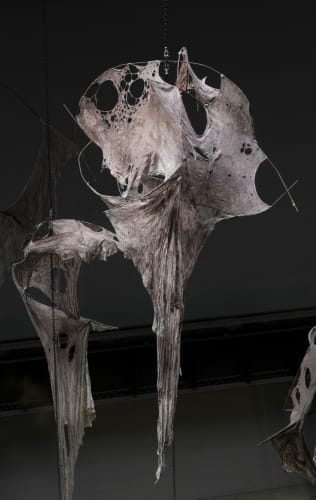HYUNDAI COMMISSION: MIRE LEE: OPEN WOUND
Tate Modern today unveils a new large-scale sculptural installation by artist Mire Lee, who reimagines the Turbine Hall as the inside of a body, transforming it into an eerie and fantastical factory. Blending her interest in rigid mechanical systems and soft organic forms with the industrial history of Tate Modern’s architecture, the work considers the emotional and physical impact of living in a world affected by precarity and decline. As the artist’s first major presentation of work in the UK, the installation sees Lee explore the tension between beauty and the grotesque on an unrivaled scale. This is the ninth annual Hyundai Commission to land at Tate.
SUSPENDING ‘SKINS’ ON METAL CHAINS
Hyundai Commission: Mire Lee: Open Wound, realizes the Turbine Hall as a construction site, filling it with membranous fabric sculptures the artist calls ‘skins’, suspended from the ceiling on 54 metal chains. At the east end of the hall, a seven-meter-long turbine hangs from one of the building’s original cranes, especially recommissioned for this installation. This motorized mechanical device is a nod to the eponymous coal and oil-fired turbines that once occupied the heart of Tate Modern during the building’s former life as the Bankside Power Station. Lee reawakens the building’s industrial past by removing the casing from the Turbine Hall bridge to offer a glimpse into its inner workings.
THE DUALITY OF REGENERATION AND DECAY
The new work also looks towards the duality of regeneration and decay. Slowly spinning, the industrial turbine assumes surprisingly human qualities, pumping dark pink viscous liquid through dangling vein-like silicone tubes, collecting in a large sloping tray underneath. Here, fabric sculptures made from construction mesh and bent steel rebar hang, absorbing the liquid to form new ‘skin’ sculptures. Technicians carry these to drying racks, a process that feels both artisanal and suggestive of an industrial production line.
Once dry, the skins are hoisted onto the chains suspended from the ceiling, redolent of the pulley systems used in coal miner’s changing rooms to dry uniforms and keep clothing clean, a liminal space between their labor and personal lives. Suggestive of anatomy, the skin speaks of vulnerability, the necessity of care and human touch, and the production of new bodies and identities. Throughout the commission’s run, the number of new hanging skins will increase, creating a sense of the building ‘shedding’ increasingly over time.
Materiality is central to Lee’s practice, and she exploits the visceral qualities of her sculptures and installations to generate emotional reactions. Employing her distinct visual language that creates organic, fleshy forms from industrial materials, Hyundai Commission: Mire Lee: Open Wound presents a world of contrasts and thresholds: human and machine, soft and hard, inside and outside, individual and collective. The installation is intended to have an unsettling effect on the viewer, evoking a range of contradictory emotions, including feelings of tenderness and empathy, as well as melancholy, awe, and disgust. Engaging the senses on a bodily level, Lee considers our fears, vulnerabilities, hopes, and desires as we stand together on the brink of an uncertain future.
Born in South Korea in 1988, Mire Lee lives and works between Amsterdam and Seoul. Using industrial materials such as steel, cement, silicone, oil and clay, her work explores the animated nature of these materials as they pour, drip and bulge. Lee is interested in the power of sculpture to affect both the viewer and the immediate surroundings and is unafraid to push artistic boundaries in spectacular ways. Her atmospheric sculptures and installations engage the senses and create spaces to reflect on themes of emotion, precarity, and human desire.
—Lea Zeitoun


